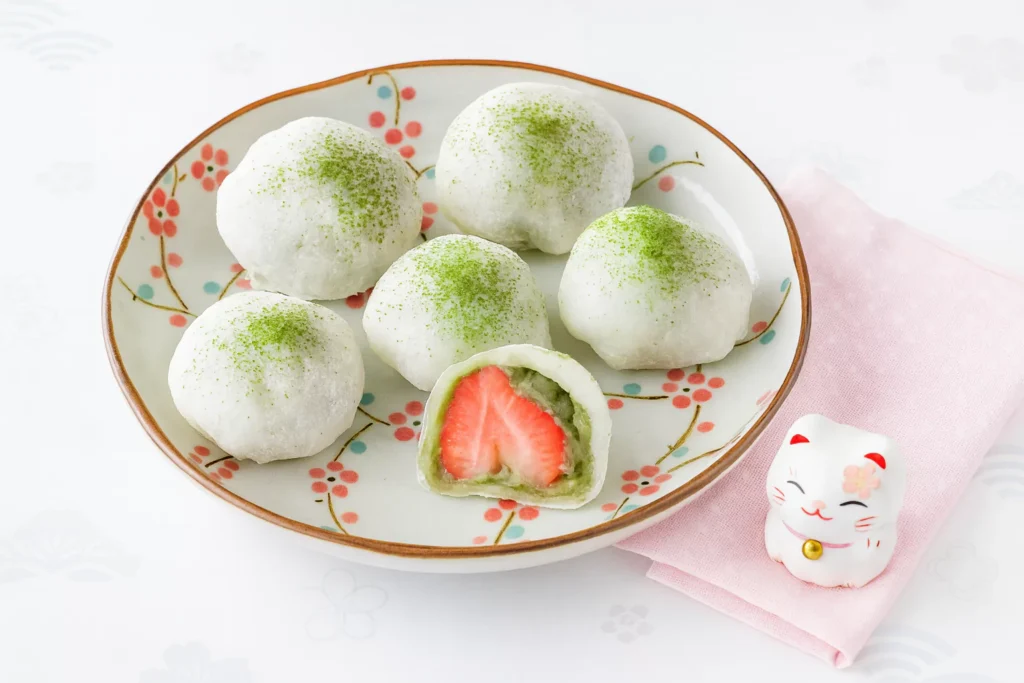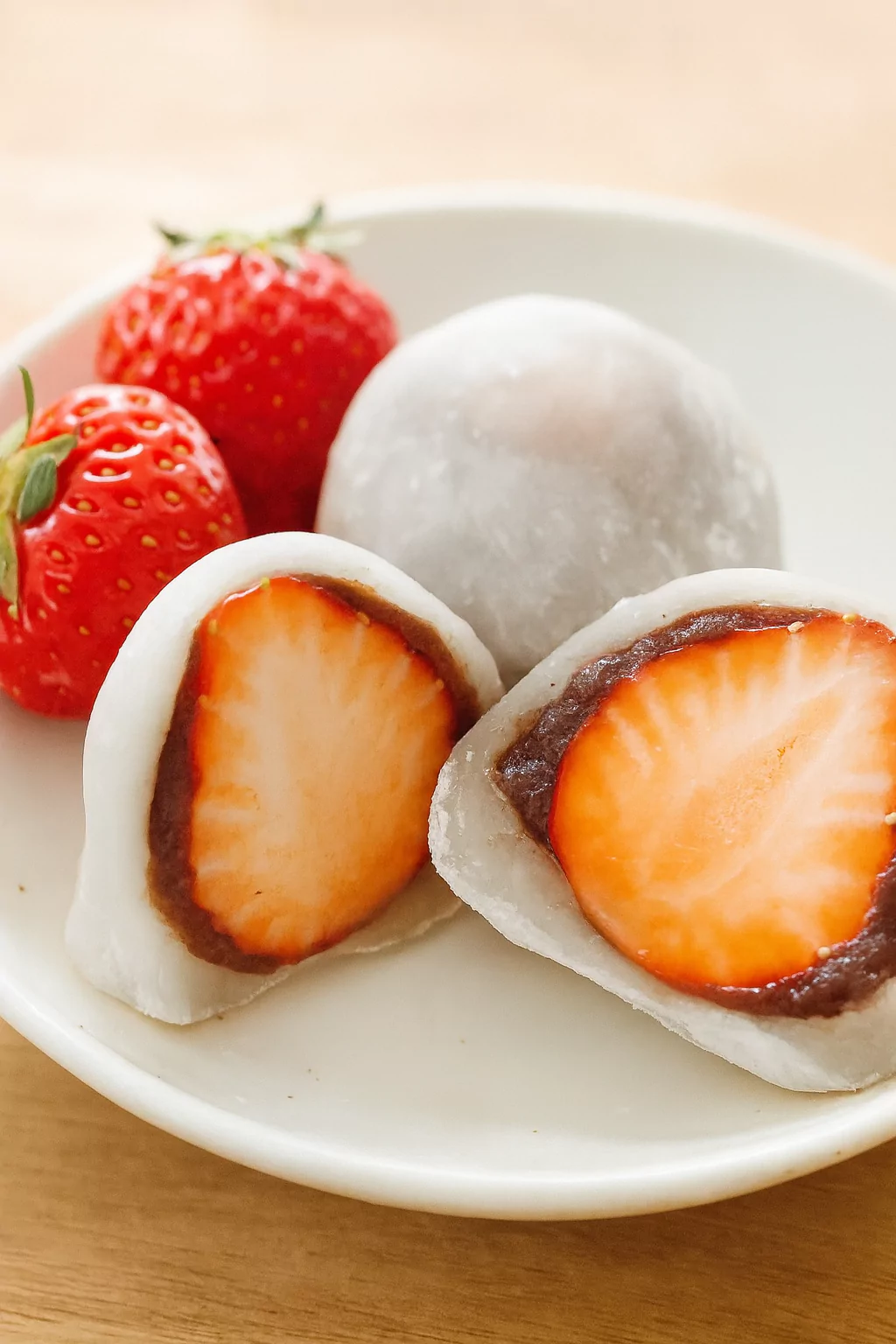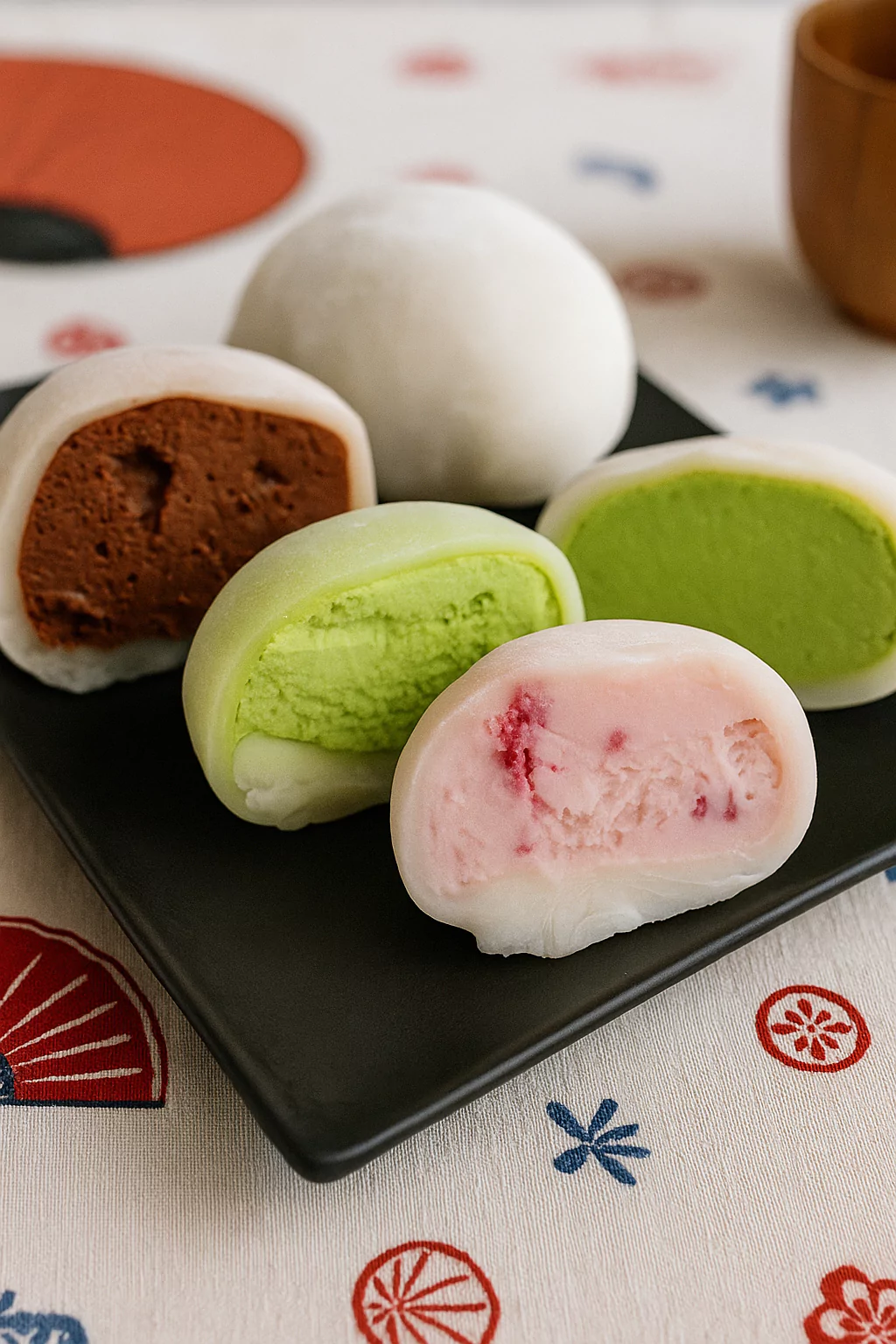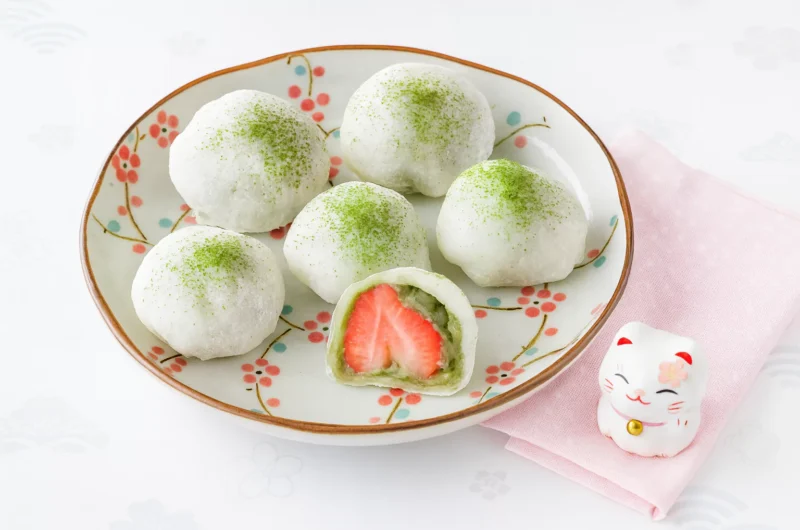Have You Ever Tasted a Strawberry Hiding in a Cloud of Matcha Mochi?
Imagine biting into something soft and chewy… only to find a sweet surprise hiding inside. A juicy strawberry wrapped in creamy white bean paste and matcha-flavored mochi—it’s like a little treasure wrapped in a soft green pillow. That’s the magic of Strawberry Matcha Daifuku Mochi, or in Japanese, いちご抹茶大福餅.
This treat isn’t just beautiful to look at. It’s also a fun dessert you can make at home—even if you’re not a professional chef. Want to learn how? Keep reading to find out how to make your own batch of this Japanese favorite, step by step.
What Is Strawberry Matcha Daifuku Mochi (いちご抹茶大福餅)?
Strawberry Matcha Daifuku Mochi (いちご抹茶大福餅) is a delightful Japanese sweet treat made of three parts:
- A whole fresh strawberry in the center
- Surrounded by a layer of sweet white bean paste (called shiroan)
- Wrapped in soft, chewy mochi dough flavored with matcha (green tea powder)
The name “daifuku” means “great luck” in Japanese, and this dessert has been a favorite in Japanese households for generations. The addition of matcha adds a gentle earthy taste that balances the sweetness of the white bean paste and the tart freshness of the strawberry. Together, these flavors create a treat that is rich, refreshing, and visually stunning.
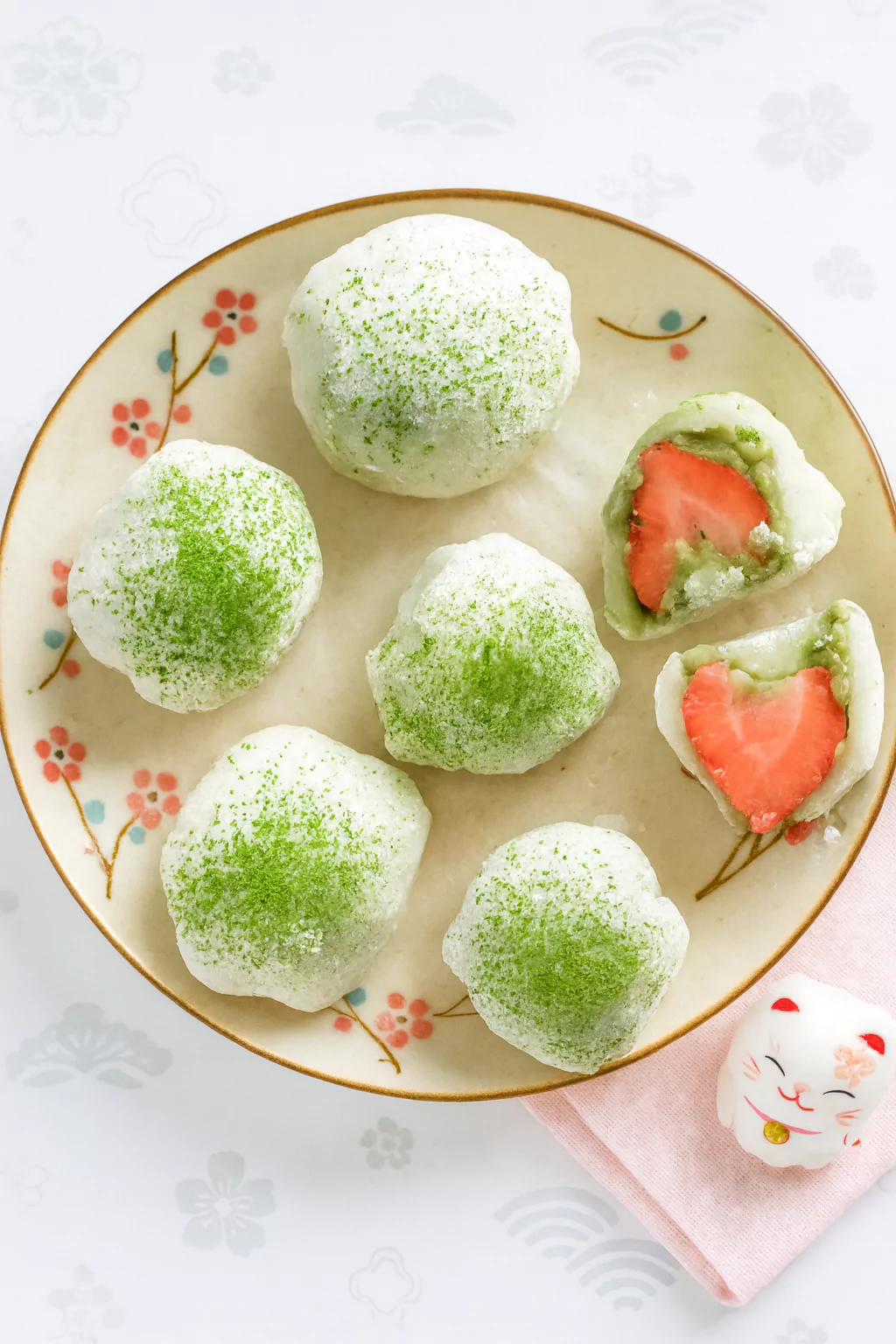
Strawberry Matcha Daifuku Mochi (いちご抹茶大福餅) @JapanDishes
Why This Recipe Is So Special
Strawberry Matcha Daifuku Mochi is not just a dessert—it’s an experience. The soft mochi, the creamy bean paste, and the fresh burst of fruit make every bite exciting. And even better, this dessert is:
- Quick to make (less than 30 minutes)
- Beginner-friendly (no baking or special machines needed)
- Fun to assemble (great for kids and families)
- Naturally gluten-free
Whether you’re celebrating a special occasion or just craving something sweet, this treat brings a taste of Japan to your kitchen.
Essential Ingredients
Here’s what you need to make 6 pieces of Strawberry Matcha Daifuku Mochi:
Core Ingredients:
- 6 small strawberries – Washed and cored. Choose ripe and firm berries so they don’t release too much juice.
- 180g white bean paste (shiroan) – A sweet, smooth paste that pairs perfectly with fruit. Can be bought or made at home.
- 1/4 tsp matcha (0.5g) – This gives the mochi its green tea flavor and color.
- 100g shiratamako (glutinous rice flour) – This makes the mochi soft and chewy. You can use mochiko as a substitute.
- 20g sugar (2 tbsp) – Adds just the right amount of sweetness to the mochi dough.
- 100g water – Helps form the dough.
- Katakuriko (potato starch) – Used for dusting to keep everything from sticking.
Substitutions:
- Shiratamako → Mochiko (the texture will be a little softer but still tasty)
- White bean paste → Red bean paste (anko) for a traditional twist
- Matcha → Leave it out for plain mochi, or replace with cocoa for a chocolate version
Step-by-Step Instructions
Let’s walk through how to make these matcha daifuku mochi at home.
Step 1: Make the Filling
- Mix the white bean paste with matcha powder in a bowl until fully blended and green.
- Divide the mixture into 6 equal portions. Flatten each portion in your hand and wrap it around a strawberry, sealing the strawberry completely in the paste. Set aside.
Step 2: Prepare the Mochi Dough
- In a mixing bowl, combine the shiratamako, sugar, and water. Stir until smooth.
- Pour the mixture into a microwave-safe bowl. You can place a damp washcloth underneath to prevent drying out.
- Cover the bowl with plastic wrap or a plate.
- Microwave for 2 minutes and 30 seconds.

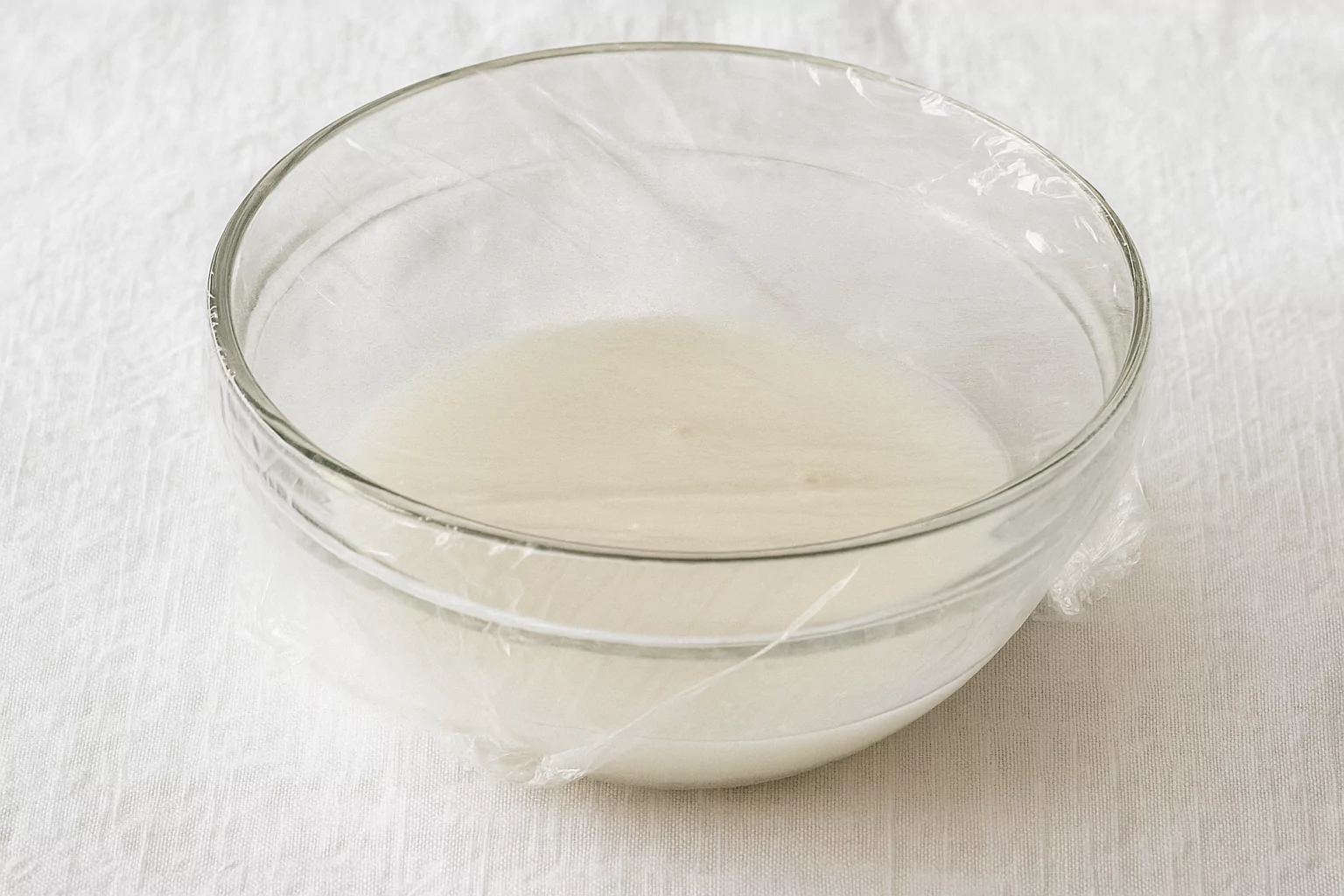
The dough should come out thick and sticky.
Step 3: Divide the Mochi
- Lightly dust a clean surface with katakuriko.
- Carefully scoop the hot mochi onto the surface.
- Divide it into 6 equal pieces using a wet knife or spatula.
- Cover the unused pieces with a damp cloth to keep them from drying.
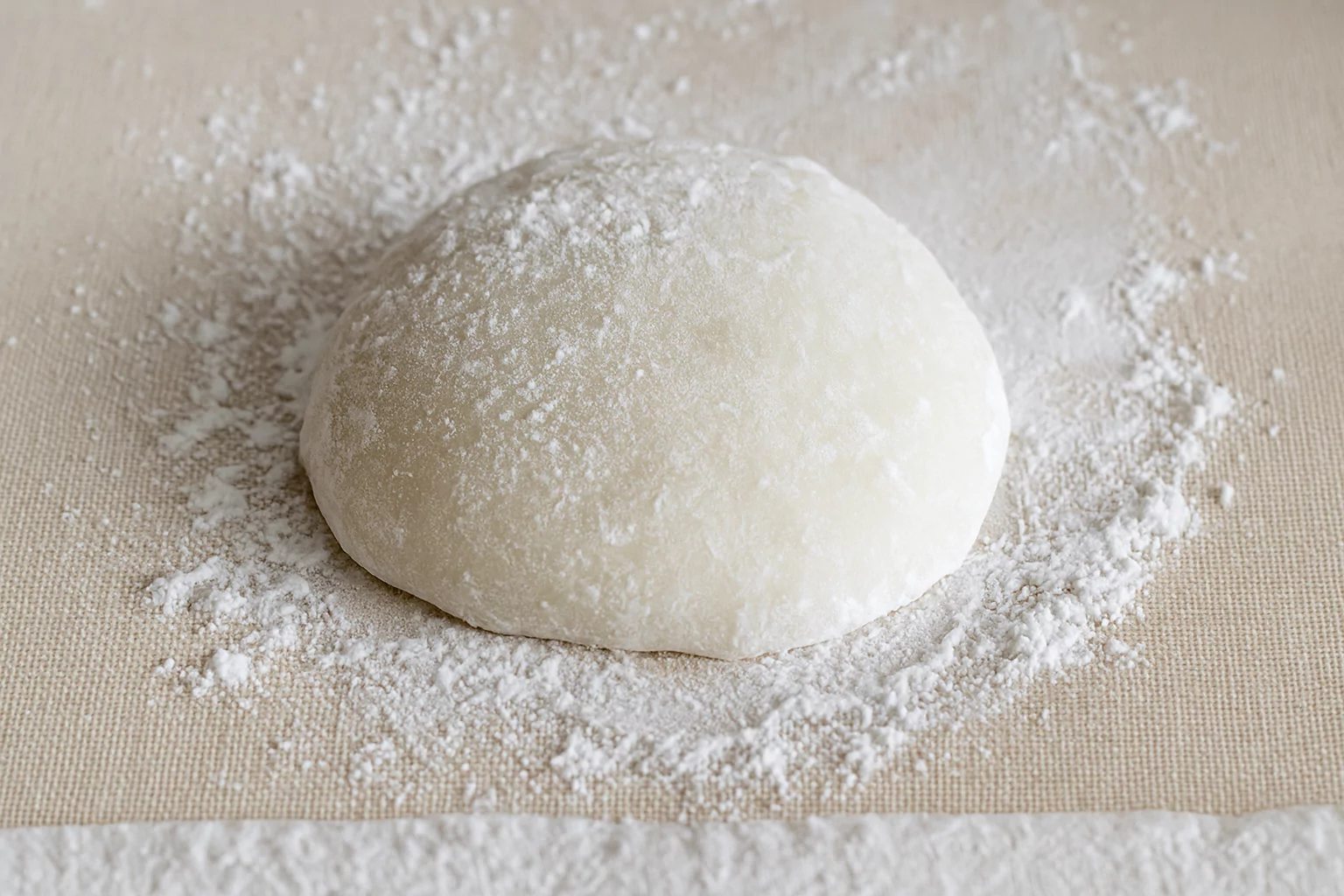
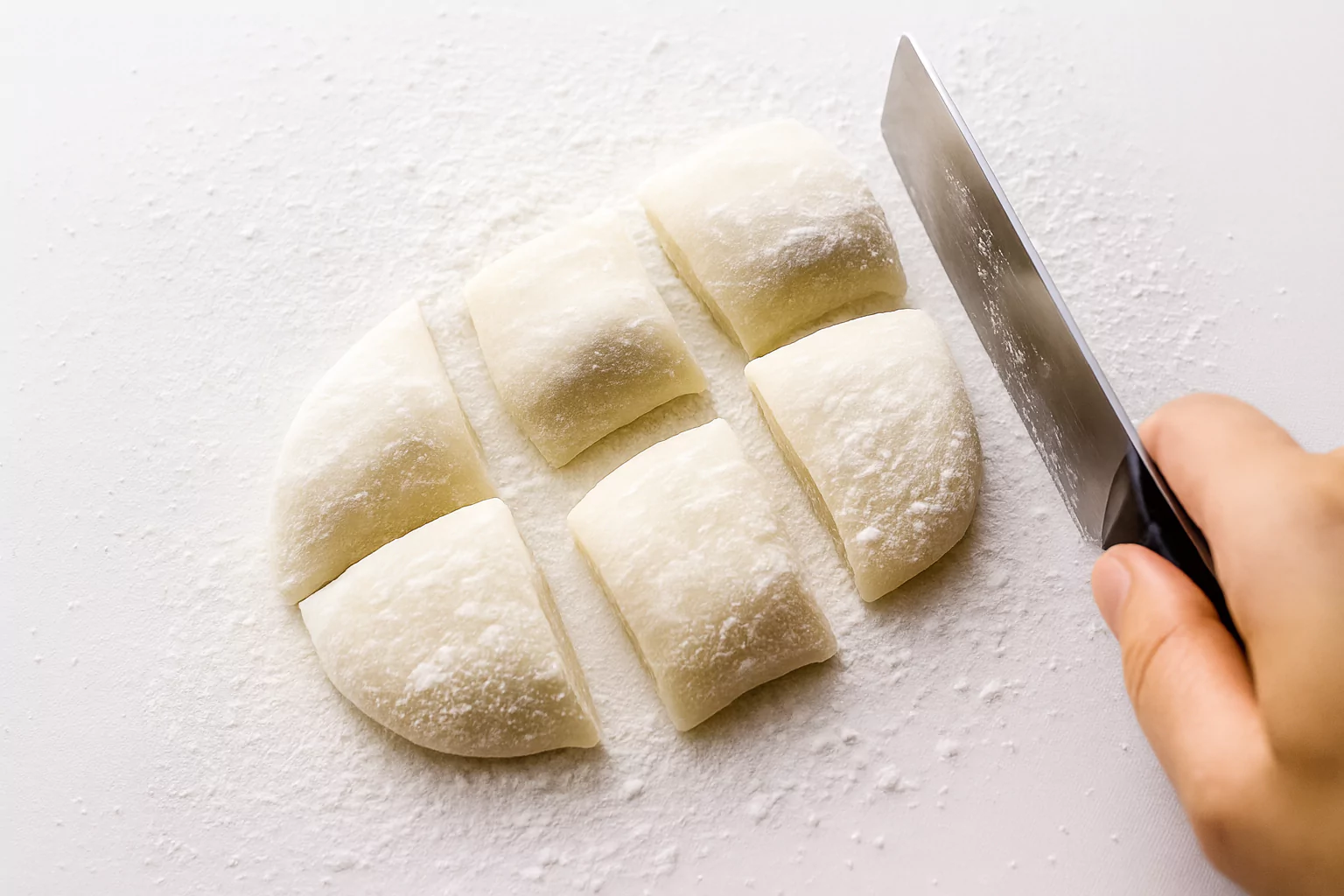
Step 4: Wrap the Fillings
- Flatten one piece of mochi into a thin round using your hand or a small rolling pin.
- Place one strawberry-bean ball in the center.
- Gently stretch the mochi over the filling and pinch the ends to close.
- Lightly dust the finished daifuku in katakuriko to prevent sticking.
- Optional: Add a dusting of extra matcha powder on top for decoration.
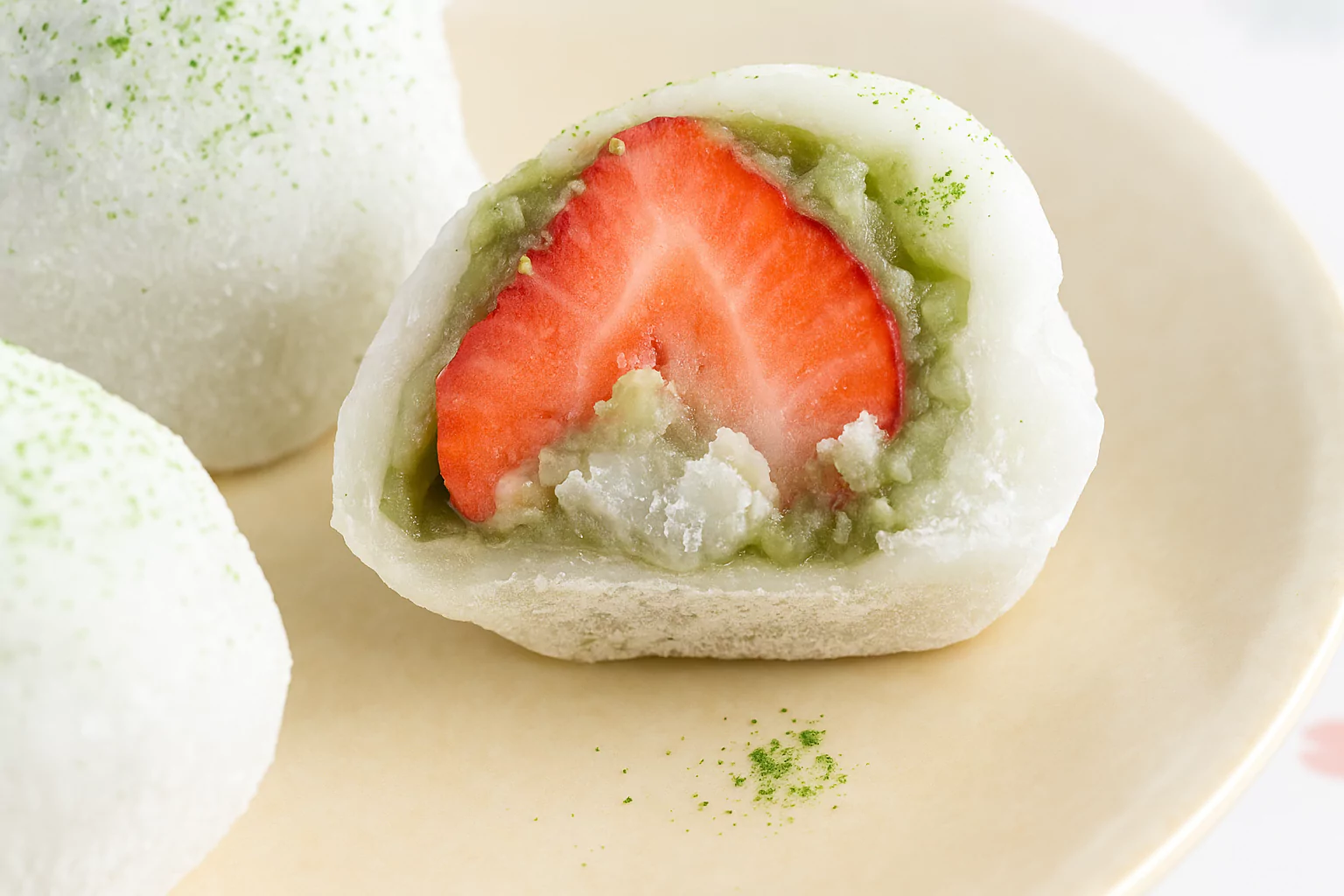
Secrets to Success and Expert Tips
- Work Quickly: Mochi hardens as it cools. Handle it while it’s warm but not too hot.
- Keep it Dusty: Use katakuriko generously. It helps prevent sticky hands and ruined mochi.
- Seal it Well: When wrapping, make sure the mochi seals completely. This keeps the strawberry fresh inside.
- Size Matters: Use small strawberries so the daifuku is easy to wrap and eat.
Assembly Tips and Presentation Ideas
Putting it all together is the most fun part.
- Smooth finish: After wrapping, gently shape the mochi into a round ball with your hands.
- Pretty topping: Dust the top with matcha for a green finish or powdered sugar for a soft look.
- Cut in Half: Serve sliced in half to show the beautiful layers of green mochi, white paste, and red berry.
- Traditional style: Place on a small Japanese plate or tray with a paper doily for an elegant look.
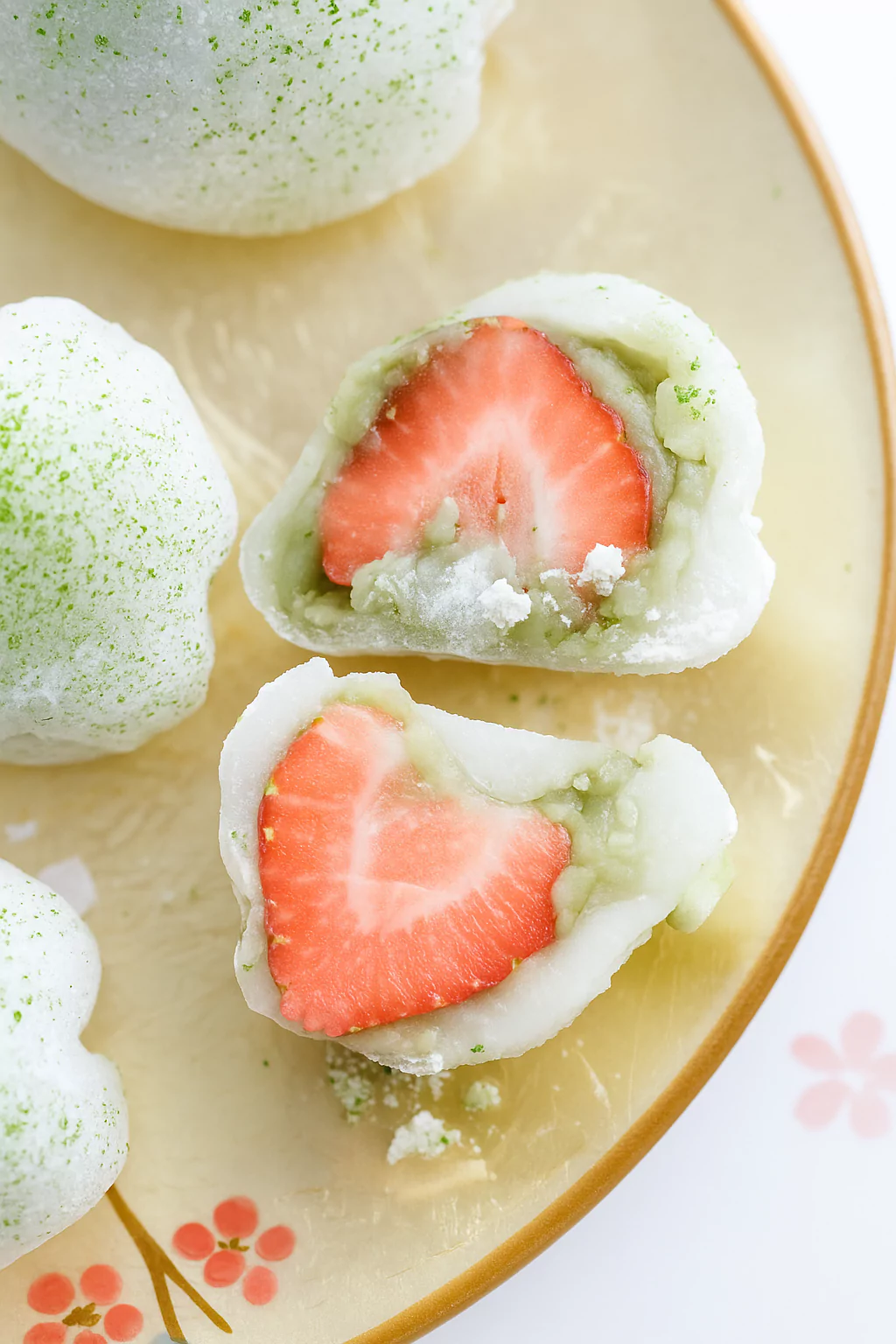
Strawberry Matcha Daifuku Mochi (いちご抹茶大福餅) @JapanDishes
Hana’s Recipe Tips
If you’re new to making mochi at home, don’t worry. Here are some tips from Hana:
- “Keep your hands cold and slightly damp when working with mochi—it won’t stick as much.”
- “Use cling film to help wrap the mochi without it breaking.”
- “If you don’t want to use the microwave, you can steam the mochi dough for about 15 minutes instead.”
- “Always eat mochi fresh—it’s softest and tastiest on the same day.”
Storage and Make-Ahead Tips
Mochi is best eaten fresh, but here are some tips if you need to store it:
- Room Temperature: Can sit out for 4–6 hours if the room is cool and dry.
- Refrigerator: Store in an airtight container lined with paper towel. It will harden a little but still be tasty within 24 hours.
- Freezing: Wrap each piece tightly in plastic wrap and freeze. Defrost at room temperature for about 30 minutes before serving. The texture may change slightly.
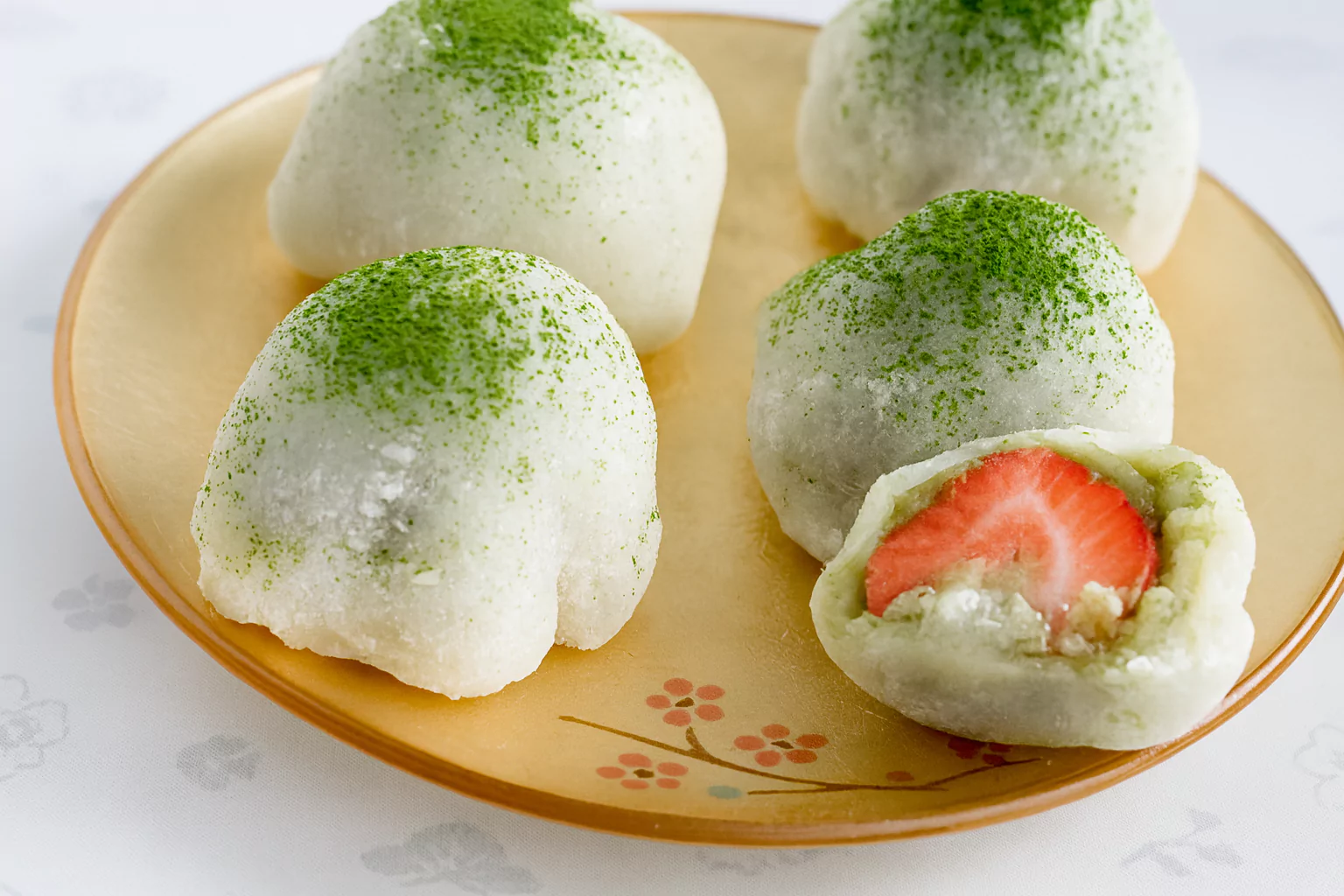
Strawberry Matcha Daifuku Mochi (いちご抹茶大福餅) @JapanDishes
Creative Variations to Try
Want to get creative with your daifuku? Try these fun twists:
- Chocolate Daifuku: Replace matcha with cocoa powder in the mochi dough.
- Mango or Kiwi Filling: Use small mango cubes or kiwi instead of strawberries for a tropical flavor.
- Yuzu Zest: Add a little grated yuzu peel to the white bean paste for a citrus note.
- Red Bean Daifuku: Use red bean paste (anko) for a classic daifuku version.
- Sakura Version: Add pickled cherry blossom leaf for a springtime feel.
Bonus: For Those Who Love Japan Travel & Culture
If you enjoy making Japanese desserts like Strawberry Matcha Daifuku Mochi (いちご抹茶大福餅), you might also love exploring Japan itself its food, traditions, and hidden paths. For travelers eager for inspiration, tips, and updates on what’s happening in Japan, check out this life‑changing travel guide: Kumano Kodo: 7 Reasons Why This Trail Is Life‑Changing.
That article covers:
- A historic pilgrimage route in Japan
- Cultural, spiritual, and natural wonders along the trail
- Practical travel tips and food along the way
If you ever plan a trip to Japan, it’s a great resource for combining food, nature, and culture in one journey.
Conclusion: Let’s Make This Sweet Surprise Together
Now that you’ve learned how to make Strawberry Matcha Daifuku Mochi (いちご抹茶大福餅), why not give it a try in your kitchen? This dessert brings the magic of Japan into your home with every soft, chewy, sweet, and juicy bite.
It’s fun, beautiful, and easy to make—even if you’re just starting out. The process is calming, the flavors are refreshing, and the final result is a treat you’ll want to share with family and friends.
Don’t be afraid to experiment with different fillings or flavors. Once you master the mochi dough, the possibilities are endless.
FAQs
Q1: Is Strawberry Matcha Daifuku Mochi healthy?
Yes, it can be. Strawberries are rich in vitamin C and antioxidants. Matcha contains green tea benefits like energy and focus. Plus, white bean paste is lower in fat than many other dessert fillings.
Q2: Can I make it without a microwave?
Absolutely. You can steam the mochi dough in a steamer for about 12–15 minutes. Just make sure to cover the bowl so moisture doesn’t drip in.
Q3: Is it gluten-free?
Yes. Mochi is made from glutinous rice flour, which contains no gluten. Always check labels to be sure.
Q4: How long does it stay fresh?
It’s best eaten the same day, but you can store it for one day in the fridge or freeze it for longer. Fresh is always best for the softest mochi texture.
Q5: Can I use other fruits?
Yes. Mango, kiwi, or even small orange segments work well. Choose fruits that are firm and not too juicy to avoid soggy daifuku.
Let the kitchen be your happy place and enjoy the art of Japanese sweets with every handmade bite.
If you liked this recipe, don’t forget to explore more Japanese treats on our site. Happy cooking!
Strawberry Matcha Daifuku Mochi いちご抹茶大福餅
Course: DessertCuisine: JapaneseDifficulty: Easy6
servings20
minutes3
minutes160
kcalIngredients
6 small fresh strawberries (washed and cored)
180 g white bean paste (shiroan)
¼ tsp matcha powder (about 0.5 g)
100 g shiratamako (glutinous rice flour) – mochiko can also work
20 g sugar (around 2 tbsp)
100 g water
Katakuriko (potato starch) for dusting
Directions
- Prepare the filling: Mix the white bean paste with matcha powder until smooth. Divide into 6 portions. Flatten each one and wrap it around a strawberry, covering completely. Set aside.
- Make the mochi dough: In a bowl, combine shiratamako, sugar, and water. Stir well until there are no lumps. Transfer to a microwave-safe bowl, cover, and cook for 2 minutes 30 seconds. If steaming, cover and steam for 12–15 minutes.
- Shape the dough: Dust your work surface with katakuriko. Place the hot mochi onto the surface and divide into 6 equal pieces. Keep unused pieces covered with a damp cloth to prevent drying.
- Wrap the fillings: Flatten one piece of mochi into a round. Place a strawberry-and-bean paste ball in the center. Gently stretch the mochi over the filling and pinch the edges to seal. Roll gently into a ball. Repeat with the remaining pieces.
- Finish: Dust the finished mochi with katakuriko. Optionally, sprinkle with a touch of extra matcha powder before serving.
Notes
- ✪ Use small, firm strawberries for easier wrapping.
✪ Work quickly while the mochi is warm so it stays pliable.
✪ Best eaten the same day for the freshest, softest texture.
✪ Store leftovers in an airtight container for up to 24 hours in the refrigerator, but expect firmer mochi.
